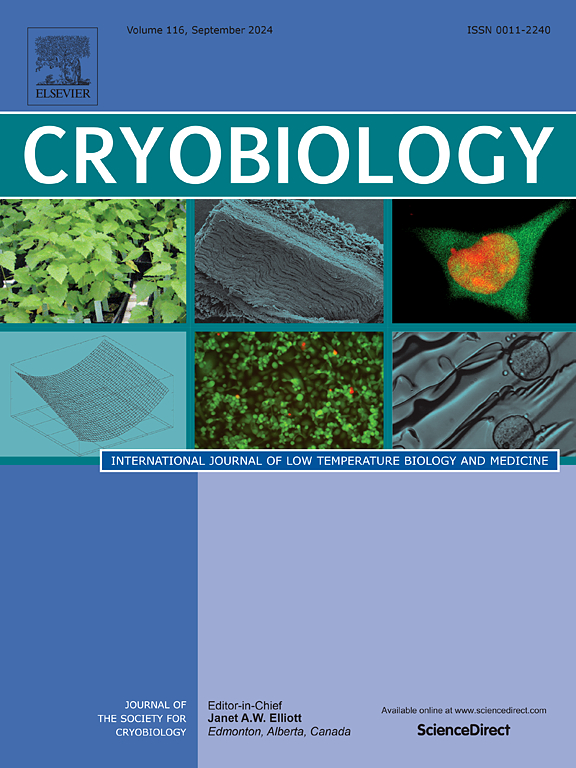Detecting changes of testicular interstitial cell membranes with a fluorescent probe after incubation and cryopreservation with cryoprotective agents
IF 2.3
3区 生物学
Q2 BIOLOGY
引用次数: 0
Abstract
Membrane alterations are among central factors predetermining cell survival during cryopreservation. In the present research, we tested some serum-/xeno-free cryoprotective compositions including dimethyl sulfoxide (Me2SO) and polymers for their osmotic impact and toxicity towards testicular interstitial cells (ICs). IC survival was determined after their contact with Me2SO, dextran (D40), hydroxyethyl starch (HES), polyethylene glycols (PEG1500 and PEG400), or after cryopreservation and cryoprotective agent (CPA) removal. A ratiometric fluorescent membrane probe 2-(2′-hydroxyphenyl)-5-phenyl-1,3-oxazole (probe O1O) was applied to assess changes in the plasma membrane of ICs. The cell survival study has shown that Me2SO decreased IC survival in a time- and dosage-dependent manner. The CPA decreased the metabolic activity of ICs, thus implying its toxic effect on the living cell as a whole. Using probe O1O, we have demonstrated that the toxic effect also influenced the plasma membrane. IC membranes were not altered after incubation with 0.7 M Me2SO. The presence of D40, HES, or PEGs in such Me2SO containing media resulted in plasma membrane hydration and damage to the membranes of cells incubated with PEGs. Cryopreservation caused pronounced membrane dehydration of the survived ICs even after CPA removal in PEG-containing media and low indicators of IC survival. Interestingly, cryopreservation with the best cryoprotective media supplemented with 0.7 M Me2SO and 100 mg/ml D40 resulted in minimal membrane alterations, thus implying its higher ability to protect membranes during cryopreservation.
用荧光探针检测睾丸间质细胞膜在使用低温保护剂孵育和低温保存后的变化。
在低温保存过程中,膜的改变是决定细胞存活的主要因素之一。在本研究中,我们测试了一些无血清/无xeno冷冻保护成分,包括二甲亚砜(Me2SO)和聚合物对睾丸间质细胞(ICs)的渗透影响和毒性。在与Me2SO、葡聚糖(D40)、羟乙基淀粉(HES)、聚乙二醇(PEG1500和PEG400)接触或冷冻保存和去除冷冻保护剂(CPA)后,测定其IC存活率。采用比例荧光膜探针- 2-(2′-羟基苯基)-5-苯基-1,3-恶唑(探针o10)来评估ic质膜的变化。细胞存活研究表明,Me2SO以时间和剂量依赖的方式降低IC存活。CPA降低了ic的代谢活性,从而暗示其对整个活细胞的毒性作用。利用探针o10,我们证明了毒性效应也影响了质膜。0.7 M Me2SO孵育后,IC膜未发生改变。在含有Me2SO的培养基中存在D40、HES或peg会导致质膜水合作用,并对与peg孵育的细胞膜造成损伤。即使在含peg的培养基中去除CPA后,冷冻保存也会导致存活的IC明显的膜脱水,并且IC存活的指标很低。有趣的是,添加0.7 M Me2SO和100 mg/ml D40的最佳冷冻保护介质冷冻保存时,膜的改变最小,这表明其在冷冻保存过程中具有更高的保护膜的能力。
本文章由计算机程序翻译,如有差异,请以英文原文为准。
求助全文
约1分钟内获得全文
求助全文
来源期刊

Cryobiology
生物-生理学
CiteScore
5.40
自引率
7.40%
发文量
71
审稿时长
56 days
期刊介绍:
Cryobiology: International Journal of Low Temperature Biology and Medicine publishes research articles on all aspects of low temperature biology and medicine.
Research Areas include:
• Cryoprotective additives and their pharmacological actions
• Cryosurgery
• Freeze-drying
• Freezing
• Frost hardiness in plants
• Hibernation
• Hypothermia
• Medical applications of reduced temperature
• Perfusion of organs
• All pertinent methodologies
Cryobiology is the official journal of the Society for Cryobiology.
 求助内容:
求助内容: 应助结果提醒方式:
应助结果提醒方式:


